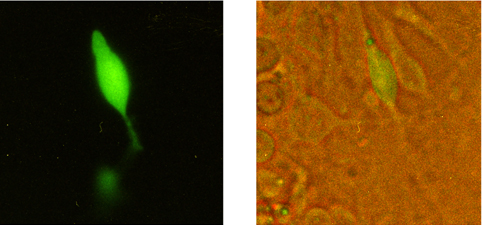![]() Figure 4 of
Boatright, Mol Vis 3:15, 1997.
Figure 4 of
Boatright, Mol Vis 3:15, 1997.
Figure 4. Transfection of E10 chick retinal cultures with the IRBP promoter (-1783/+101 fragment) driving the green fluorescent protein (EGFP) gene.
(a) 10 µg of the plasmid p1783-EGFP, containing the -1783 to +101 fragment of the mouse IRBP promoter cloned into the BamHI site of pEGFP-1 (Clontech), was used to transfect cultures via calcium phosphate precipitation. Photos were taken two days after transfection and are of four representative cells that fluoresce after transfection of the cultures. Only a few hundred cells fluoresce brightly per 60 mm dish, suggesting that transfection efficiency is low or that only a small fraction of cells in these cultures can express the promoter-reporter construct. Importantly, only cells with a morphology distinctly resembling photoreceptors fluoresce. Morphology suggests an axon with pedicle at the bottom, a cell body in the middle, and an inner segment with a rudimentary outer segment near the top of the photographs.

(b) Comparison of fluorescence and bright field of putative photoreceptor transfected with p1783-EGFP. The left photograph is with fluorescence lighting only. The right photograph is the same field with the transmission light turned up enough to observe an oil droplet in the same cell. The presence of an oil droplet is characteristic of photoreceptor cells in chickens.
